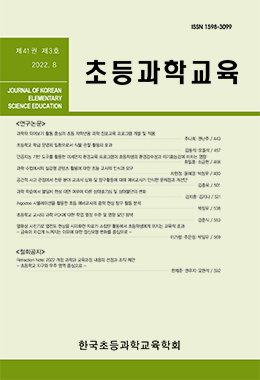본 연구는 ‘금속이 차갑게 느껴지는 이유’를 설명하는 소집단 활동 과정에서 열화상 사진기로 열전도 현상을 시각화한 자료가 초등학생에게 미치는 교육적 효과에 대해서 알아보고자 하였다. 연구를 위해 초등 5학년 4명을 대상으로 ‘온도와 열’ 단원 학습 전후에 사전 사후 심층면담을 진행하였다. 또한 ‘금속이 차갑게 느껴지는 이유’를 설명하는 추가 차시 수업의 소집단 활동 과정에서 녹화 및 녹음 자료, 학생들의 활동지, 연구자의 연구일지 등을 수집하여, 비교·검토하였다. 연구 결과 열화상 사진기로 열전도 현상을 시각화한 자료는 호기심을 유발하고 정교한 관찰 및 통합적 사고의 기회를 제공하였다. 또한 열전도 현상을 시각화한 자료는 학생들의 소집단 활동 과정에서 활발한 의사소통을 위한 해석과 반박의 근거자료로 사용되었다. 학생들은 열화상 동영상 자료를 바탕으로 하는 소집단 토론 과정을 통해 비과학적 신념을 변화시키고 지식을 정교화하였으며 이를 바탕으로 각자의 정신모형을 발달시켰다.
This study aims to investigate the educational effects of the visualization of heat conduction using a thermal imaging camera on elementary school students through small group activities. It endeavors to explain the reason for why metal feels cold. The scholars conducted in-depth interviews before and after learning the unit “Temperature and Heat” for four students in fifth grade in Seoul. Recorded video and audio materials of the activities, their outputs, and journals of scholars were collected, reviewed, and analyzed. The result demonstrated that visualizing heat conduction using the thermal imaging camera aroused curiosity and provided an opportunity for sophisticated observation and integrated thinking. In addition, the visualization of the heat conduction phenomenon was used as the basis for interpretation and rebuttal for active communication during the small group activities of the students. Consequently, the students changed their non-scientific beliefs, refined their knowledge, and developed their mental models through a small group discussion based on a thermal image video.




